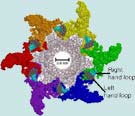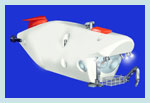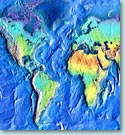| |
 |
 |
 |
|
 |
 |
 |
 |
 |

|
 |
 |
|
|
|
 |
Falloff in Freezes: Study Projects Decrease in Frost Days
|
 |
| |
 Days when the air temperature dips below freezing will become increasingly less common across much of the world by the late 21st century, according to a modeling study by scientists at the National Center for Atmospheric Research in Boulder, Colo. The reduction in days with freezes (frost days) is projected to be most dramatic across the western parts of North America and Europe. The study is the first to examine trends in frost days using a global climate model. In a paper published in the August 20 online edition of Climate Dynamics, NCAR scientists Gerald Meehl, Claudia Tebaldi and Doug Nychka examine the factors that have led to a reduction in frost days in many areas over the past 50 years. Days when the air temperature dips below freezing will become increasingly less common across much of the world by the late 21st century, according to a modeling study by scientists at the National Center for Atmospheric Research in Boulder, Colo. The reduction in days with freezes (frost days) is projected to be most dramatic across the western parts of North America and Europe. The study is the first to examine trends in frost days using a global climate model. In a paper published in the August 20 online edition of Climate Dynamics, NCAR scientists Gerald Meehl, Claudia Tebaldi and Doug Nychka examine the factors that have led to a reduction in frost days in many areas over the past 50 years.
Image: Getty Images/PhotoDisc
Read the full story. ... Posted
8/25/04
|
 |
From Moonbounce to Hard Drives: Correcting More Errors Than Previously Thought Possible
|
 |
| |
 Princeton University's Joseph Taylor, ham radio operator and recipient of the 1993 Nobel Prize in Physics, bounces radio signals off the moon. Amateur radio operators use such moonbounce signals to make long-distance contacts, pushing the limits of radio communications, and Taylor has developed a computer program to get better reception of digital messages encoded in the extremely weak signals. Now, thanks to two pairs of NSF-supported scientists whose breakthroughs turned almost 40 years of conventional wisdom in communications theory on its head, Taylor's program can detect messages in moonbounce signals nearly two times fainter than before. Princeton University's Joseph Taylor, ham radio operator and recipient of the 1993 Nobel Prize in Physics, bounces radio signals off the moon. Amateur radio operators use such moonbounce signals to make long-distance contacts, pushing the limits of radio communications, and Taylor has developed a computer program to get better reception of digital messages encoded in the extremely weak signals. Now, thanks to two pairs of NSF-supported scientists whose breakthroughs turned almost 40 years of conventional wisdom in communications theory on its head, Taylor's program can detect messages in moonbounce signals nearly two times fainter than before.
Image: Michael Connors/Morguefile
Read the full story. ... Posted
8/25/04
|
 |
Periodic Dimming of Bright Starlight Reveals Distant Planet
|
 |
| |
 Using a network of small telescopes and the "transit method" of detection, scientists have made their first direct discovery of a planet orbiting a bright star. A periodic dimming of light from a bright star 500 light-years away revealed the planet's presence. The star's intense light will allow scientists to explore the chemical makeup of the planet's atmosphere in future observations. A paper on the recent discovery appeared on-line in The Astrophysical Journal Letters. "This effort further develops the 'transit method' and lays the groundwork for more research into the composition of the atmospheres surrounding planets outside our solar system," said Cliff Jacobs, program director in NSF's division of atmospheric sciences, which funded the discovery. Using a network of small telescopes and the "transit method" of detection, scientists have made their first direct discovery of a planet orbiting a bright star. A periodic dimming of light from a bright star 500 light-years away revealed the planet's presence. The star's intense light will allow scientists to explore the chemical makeup of the planet's atmosphere in future observations. A paper on the recent discovery appeared on-line in The Astrophysical Journal Letters. "This effort further develops the 'transit method' and lays the groundwork for more research into the composition of the atmospheres surrounding planets outside our solar system," said Cliff Jacobs, program director in NSF's division of atmospheric sciences, which funded the discovery.
Image: David A. Aguilar, Harvard-Smithsonian Center for Astrophysics
Read the full story. ... Posted
8/25/04
|
 |
Viruses on the Attack
Revealing visuals show details of a common mechanism for infection
|
 |
| |
 Using a combination of imaging techniques, researchers have determined the mechanics that allow some viruses to invade cells by piercing their outer membranes and digesting their cell walls. The researchers combined their findings with earlier studies to create a near-complete scenario for that form of viral assault. The results have a dual benefit: they show the inner workings of complex, viral nanomachines infecting cells (in a process nearly identical to some viral infections of human cells) and the images provide design tips for engineers hoping to build the gene delivery devices of the future. Using a combination of imaging techniques, researchers have determined the mechanics that allow some viruses to invade cells by piercing their outer membranes and digesting their cell walls. The researchers combined their findings with earlier studies to create a near-complete scenario for that form of viral assault. The results have a dual benefit: they show the inner workings of complex, viral nanomachines infecting cells (in a process nearly identical to some viral infections of human cells) and the images provide design tips for engineers hoping to build the gene delivery devices of the future.
Image: Purdue University and Seyet LLC
Read the full story. ... Posted
8/20/04
|
 |
Frontiers Spotlights NSF-Supported Discoveries, Research Results
|
 |
| |
 NSF's investments in science, engineering, education and technology help to create knowledge and sustain prosperity. Now our updated Frontiers website presents the stories behind some of the results made possible by NSF's investments, conveying the meaning and the thrill of discovery to all audiences. Find out about: researchers who are developing an artificial retina to restore partial sight; the origins of Web browsers and a popular Web search engine; discoveries of powerful toxins that may someday help fight disease in humans; work on a new method of visualization that sheds light on objects as tiny as proteins in a cell membrane; searches for planets outside of our solar system; and much more. Once you've spent time on our Frontiers of science and engineering, you'll understand why we say NSF is where discoveries begin. NSF's investments in science, engineering, education and technology help to create knowledge and sustain prosperity. Now our updated Frontiers website presents the stories behind some of the results made possible by NSF's investments, conveying the meaning and the thrill of discovery to all audiences. Find out about: researchers who are developing an artificial retina to restore partial sight; the origins of Web browsers and a popular Web search engine; discoveries of powerful toxins that may someday help fight disease in humans; work on a new method of visualization that sheds light on objects as tiny as proteins in a cell membrane; searches for planets outside of our solar system; and much more. Once you've spent time on our Frontiers of science and engineering, you'll understand why we say NSF is where discoveries begin.
Image: National Science Foundation
Visit Frontiers at http://www.nsf.gov/od/lpa/frontiers/. ... Posted
8/20/04
|
 |
Geologists Host Tour Of San Andreas Fault On Sept. 2nd
EarthScope Project Scientists Lead Modern-Day 'Journey to the Center of the Earth'
|
 |
| |
 In a modern-day journey to the center of the Earth, geologists are exploring the structure and evolution of the North American continent at scales from hundreds of kilometers to less than a millimeter -- from the structure of a continent, to individual faults, earthquakes and volcanoes. The project is called EarthScope. With approximately $200 million in funding from the National Science Foundation, EarthScope will be developed over the next five years. The project is expected to operate for an additional 15 years. On Sept. 2, scientists studying San Andreas Fault geology will provide a first look at the multiple technologies EarthScope will use to explore the structure and tectonics of North America. In a modern-day journey to the center of the Earth, geologists are exploring the structure and evolution of the North American continent at scales from hundreds of kilometers to less than a millimeter -- from the structure of a continent, to individual faults, earthquakes and volcanoes. The project is called EarthScope. With approximately $200 million in funding from the National Science Foundation, EarthScope will be developed over the next five years. The project is expected to operate for an additional 15 years. On Sept. 2, scientists studying San Andreas Fault geology will provide a first look at the multiple technologies EarthScope will use to explore the structure and tectonics of North America.
Image: EarthScope Project
Read the full story. ... Posted
8/13/04
|
 |
Future Heat Waves: More Severe, More Frequent and Longer Lasting
|
 |
| |
 Heat waves in Chicago, Paris, and elsewhere in North America and Europe will become more intense, more frequent and longer lasting in the 21st century, according to a new modeling study by two scientists at the National Center for Atmospheric Research (NCAR) in Boulder, Colo. In the United States, heat waves will become most severe in the West and South. The findings appear in the August 13 issue of the journal Science. Gerald Meehl and Claudia Tebaldi, both of NCAR, examined Earth's future climate using the Parallel Climate Model, developed by NCAR and the U.S. Department of Energy. "This study provides significant insight into the complex response of global climate to possible future worldwide economic and regulatory policies," said Cliff Jacobs, program director in NSF's division of atmospheric sciences, which funded the research. "The societal implications of this study need to be further explored." Heat waves in Chicago, Paris, and elsewhere in North America and Europe will become more intense, more frequent and longer lasting in the 21st century, according to a new modeling study by two scientists at the National Center for Atmospheric Research (NCAR) in Boulder, Colo. In the United States, heat waves will become most severe in the West and South. The findings appear in the August 13 issue of the journal Science. Gerald Meehl and Claudia Tebaldi, both of NCAR, examined Earth's future climate using the Parallel Climate Model, developed by NCAR and the U.S. Department of Energy. "This study provides significant insight into the complex response of global climate to possible future worldwide economic and regulatory policies," said Cliff Jacobs, program director in NSF's division of atmospheric sciences, which funded the research. "The societal implications of this study need to be further explored."
Image: Kenn Kiser/Morguefile
Read the full story. ... Posted
8/12/04
|
 |
No Longer Just For Biology, RNA Can Now Be Built Into 3-D Arrays
Biomaterial to be girders for nanoscale construction projects
|
 |
| |
 Researchers have coaxed RNA to self-assemble into 3-D arrays, a potential backbone for nanotech scaffolds. These RNA structures can form a wider variety of shapes than double-stranded DNA can and are easier to manipulate than many protein alternatives. Peixuan Guo of Purdue University and his colleagues report the findings in the August 11, 2004, issue of the
journal Nano Letters. RNA (ribonucleic acid) molecules are best known for implementing the genetic information encoded in DNA (deoxyribonucleic acid). However, instead of using the long molecular strings to carry information, the researchers have achieved new control over RNA and created novel arrays. By mixing the custom-made RNA strands with other substances, such as magnesium chloride, the researchers were able to get the strands to join into 3-D shapes. Researchers have coaxed RNA to self-assemble into 3-D arrays, a potential backbone for nanotech scaffolds. These RNA structures can form a wider variety of shapes than double-stranded DNA can and are easier to manipulate than many protein alternatives. Peixuan Guo of Purdue University and his colleagues report the findings in the August 11, 2004, issue of the
journal Nano Letters. RNA (ribonucleic acid) molecules are best known for implementing the genetic information encoded in DNA (deoxyribonucleic acid). However, instead of using the long molecular strings to carry information, the researchers have achieved new control over RNA and created novel arrays. By mixing the custom-made RNA strands with other substances, such as magnesium chloride, the researchers were able to get the strands to join into 3-D shapes.
Image: Peixuan Guo, Purdue University
Read the full story. ... Posted
8/11/04
|
 |
Evolution of Whale Hearing Unfolds in Fossil Record
|
 |
| |
 An international team of scientists has traced the evolution of hearing in modern cetaceans (whales, dolphins and porpoises). "This study of the early evolution of whales demonstrates the changes that took place in whales' outer and middle ears, required for the transition from a land-based to a marine-based existence," said Rich Lane, director of the National Science Foundation's geology and paleontology program, which funded the research. The findings are published in the Aug. 12 issue of the journal Nature. The ear is the most important sense organ for modern toothed whales, say scientists, because these whales locate their prey using echolocation. Directional hearing is critical: A blind such whale could find food without much trouble; a deaf one would starve. An international team of scientists has traced the evolution of hearing in modern cetaceans (whales, dolphins and porpoises). "This study of the early evolution of whales demonstrates the changes that took place in whales' outer and middle ears, required for the transition from a land-based to a marine-based existence," said Rich Lane, director of the National Science Foundation's geology and paleontology program, which funded the research. The findings are published in the Aug. 12 issue of the journal Nature. The ear is the most important sense organ for modern toothed whales, say scientists, because these whales locate their prey using echolocation. Directional hearing is critical: A blind such whale could find food without much trouble; a deaf one would starve.
Artwork by Lauren Stevens
Read the full story. ... Posted
8/11/04
|
 |
Deeper-Diving Human-Occupied Submersible to Replace Alvin
New 6500-meter vehicle will provide expanded capabilities for U.S. Scientists
|
 |
| |
 After 40 years of scientific research that led to the discovery of new life forms, helped confirm the theory of plate tectonics, and enthralled schoolchildren around the world with seafloor images and video, the research submersible Alvin will be replaced by a new, deeper-diving vehicle. The National Science Foundation (NSF) will provide funding for the human-occupied vehicle (HOV) through a cooperative agreement with the Woods Hole Oceanographic Institution (WHOI). A 2004 National Research Council (NRC) report, Future Needs of Deep Submergence Science, recommended construction of a new, more capable HOV as part of a suite of tools for ocean research, which includes remotely operated vehicles (ROVs) and autonomous underwater vehicles (AUVs). After 40 years of scientific research that led to the discovery of new life forms, helped confirm the theory of plate tectonics, and enthralled schoolchildren around the world with seafloor images and video, the research submersible Alvin will be replaced by a new, deeper-diving vehicle. The National Science Foundation (NSF) will provide funding for the human-occupied vehicle (HOV) through a cooperative agreement with the Woods Hole Oceanographic Institution (WHOI). A 2004 National Research Council (NRC) report, Future Needs of Deep Submergence Science, recommended construction of a new, more capable HOV as part of a suite of tools for ocean research, which includes remotely operated vehicles (ROVs) and autonomous underwater vehicles (AUVs).
Image: Woods Hole Oceanographic Institution
Read the full story. ... Posted
8/6/04
|
 |
Early Humans Adapted Well to Different Climates and Vegetation Types
|
 |
| |
 Early human ancestors seem to have taken different climates and vegetation types in stride as they evolved from apelike populations in Africa to a worldwide, highly diverse human species. New research supported in part by the National Science Foundation demonstrates that hominins (early human species) in what is today northern Africa lived equally well in a relatively warm and dry climate 3.4 million years ago and in a much cooler climate with significantly more rainfall and forest growth slightly later. And the species studied, Australopithecus afarensis, adapted to these dramatic environmental changes without the benefit of an enlarged brain or stone tools, which aided later hominins in adapting to their environments. These research results appear in the Proceedings of the National Academy of Sciences now online. The studies are part of a large on-going project that explores the emergence and amplification of human adaptability in the past 4 million years. Early human ancestors seem to have taken different climates and vegetation types in stride as they evolved from apelike populations in Africa to a worldwide, highly diverse human species. New research supported in part by the National Science Foundation demonstrates that hominins (early human species) in what is today northern Africa lived equally well in a relatively warm and dry climate 3.4 million years ago and in a much cooler climate with significantly more rainfall and forest growth slightly later. And the species studied, Australopithecus afarensis, adapted to these dramatic environmental changes without the benefit of an enlarged brain or stone tools, which aided later hominins in adapting to their environments. These research results appear in the Proceedings of the National Academy of Sciences now online. The studies are part of a large on-going project that explores the emergence and amplification of human adaptability in the past 4 million years.
Image: iStockPro
Read the full story. ... Posted
8/2/04
|
 Top of Page Top of Page
|
|
|
 |
 |
 |
 |
 |
 |
 |
 |
|
 |
 |
 |
|
|

